Reflecting on the possibility of the
existence of sirens, in an emblem in which he presents us
these beings, Antonio de Lorea refers the reader to
the Holy Scriptures where “sirens are mentioned just as well as
phoenix”.
Putting aside for the moment the
complex issue of sirens – to which we will return in a
later Silva, armed with the authority of the great Bible
commentator Cornelius a Lapide who actually knew a
siren in
his native Friesland – let us now focus on the phoenix. Lorea
cites it in a marginal gloss: “And as the
phoenix, I will multiply my days. Job, chapter 29”, and he
confesses to having made use of “the Hebrew version”. And this
note leads us to intuit a problem of translation.
Indeed, if we look for Job, verse 29.18 in the King
James Bible, we read: “Then I
said, 'I shall die in my nest, And multiply my days
as the
sand.'” Checking
the same verse in a different translation of the Bible, the
Jewish Publication Society’s edition from 1917, we find
following wording: “Then I said: 'I shall die with my nest,
and I shall multiply my days as the phoenix.'” We get even more confused when we look up the very
same verse in the Vulgate, where we find the following:
Dicebam que in nidulo meo moriar et sicut palma
multiplicabo dies: “And I said: I shall die in my nest, and
as a
palm tree shall multiply my days”.
One gets the feeling that the translators of the three
different versions must have had three completely different
sources to translate from. In an attempt to solve this riddle,
we turn first to the original Hebrew text of the Bible. Here
we find the word chol, the general meaning of which is indeed ‘sand’.
This interpretation is supported by other biblical verses
where the word occurs, like in the famous promise of God to
Abraham, saying: “I will greatly multiply your seed as the
stars of the heavens and as the sand which is on the seashore”
(Gen 22:17). So as a starting point, ‘sand’ sounds
like a very appropriate interpretation of our verse in
question, too. But where do the other two, more exotic
translations come from?
Comparing different translations of this verse in different
versions of the Bible, it becomes clear very soon that it is
principally the Jewish translations that use the translation
phoenix instead of
sand. This interpretation of the word chol in this particular
verse reflects an early Jewish exegetical tradition that we
find in several Jewish commentaries. One of the most
popular and influential of these from the eleventh century was
that of the French Jewish scholar and exegete Rabbi Shelomo
Yitzhaki, or Rashi, which was widely read not only by Jews,
but also by Christian Hebraists and Bible commentators. Rashi
comments on the word in our verse as follows: “It is a bird
whose name is chol, and death has no power on it, because it
did not taste the fruit from the tree of knowledge. At the end
of thousand years it renews itself, and returns to his youth.”
Rashi thus speaks about the legendary bird phoenix. Sixteenth-
and seventeenth-century Christian Hebraists were well aware of
this interpretation, and several of them refer more or less
explicitly to Rashi as their source: Juan de Pineda tells about
“Rabbi Salomon”, Johann Clemens Drusius mentions “R. S.” which
is an abbreviation of the same, while François Vatable refers
to a “certain illustrious Hebrew man”, which I suspect to be
the very same Rashi.
Rashi had of course his own sources: the early rabbinical
commentaries of the Bible, the Midrashim, on which he relied
heavily in his own commentaries. In one of those Midrashim, in
Bereshit Rabbah (19:5) we find the following commentary to
Genesis 3:6: “[Eve] gave the cattle, beasts, and birds to eat
of it [i.e. the forbidden fruit from the tree of knowledge].
All obeyed her and ate thereof, except a certain bird named
chol, as it is written, “Then I said: I shall die with my
nest, and I shall multiply my days as the chol [i.e.
‘phoenix’]” (Job 29:18). The School of R. Jannai and R. Judan
b. R. Simeon differ. The School of R. Jannai maintained:
‘It
lives a thousand years, at the end of which a fire issues from
its nest and burns it up, yet as much as an egg is left, and
it grows new limbs and lives again.’ R. Judan b. R. Simeon
said: ‘It lives a thousand years, at the end of which its body
is consumed and its wings drop off, yet as much as an egg is
left, whereupon it grows new limbs and lives again.’ ”
Bereshit Rabbah is not the only early Rabbinical source
where we find a parallel between a description of the
legendary phoenix bird and our examined verse in Job. In the
Babylonian Talmud, in the tractate Sanhedrin (108b) we hear a phantastic
eyewitness account of the days of the Flood, from the mouth of
not less an authority then Shem, Noah’s oldest son. Shem
relates with great details the matters of feeding the
different kind of animals in the ark. At one point he tells
about the phoenix: “As for the phoenix, my father discovered
it lying in the hold of the ark. "Dost thou require no food?"
he asked it. "I saw that thou wast busy," it replied, "so I
said to myself, I will give thee no trouble." "May it be
(God's) will that thou shouldst not perish," he exclaimed; as
it is written, ‘Then I said, I shall die in the nest, but I
shall multiply my days as the chol [phoenix].’ ”
From where does Bereshit Rabbah and Sanhedrin draw the odd
idea that Job 29:18 should speak about phoenix, and not
sand?
We can only guess, as we do not find any ethymological support
for this claim. Even Sanhedrin uses a completely different
word – urshina – for phoenix in the first part of the story,
which is not even distantly related morphologically or
ethymologically to chol in Job. We can, however, find a
possible explanation by analyzing the structure of the verse
in question. If we treat the two halves of the verse as
parallels, we find that the word “nest” in the first half
calls for a juxtaposition in the second part, by which it is
very logical to compare the length of Job’s life with that of
a bird. And why exactly phoenix? The order of the two half
verses might very well suggest it: in a not very logical
manner, Job first speaks of dying, and afterwards about
multiplying his days. Now it is obvious that not many living
creatures are capable of first dying in their nests and
afterwards multiplying their days; but according to the
ancient legend, exactly the phoenix can do that trick!
Another interesting parallel verse, or, one might say, prooftext
is Psalm 103:5: “Your youth is renewed like the
eagle’s”. Not only the symbolics of the verse – the mention of
a bird which somehow can return to its youth – shows a
striking parallel with our verse in question and thus supports
the traditional Jewish understanding of it, but Rashi’s
commentary to Job is taken almost word-for-word from Psalm
103:5, as if he wanted to use the verse from Psalms
implicitely as a prooftext to his commentary to Job.
The third interpretation of the word chol, namely
‘palm tree’,
which occurs in the Vulgate, suprisingly has its origins in
the above intrepretation. As we know, St. Jerome consulted
both the original Hebrew text and the Greek Septuagint, when
working on the Latin translation of the Bible, the Vulgate.
While in many dubious places he preferred the text of the
original Hebrew, in this particular case he choosed that of
the Septuagint, which has
στέλεχος φοίνικος, meaning ‘palm
trunk’, where the whole verse translates to English as
follows: “And I said, My age shall continue as the stem of a
palm-tree; I shall live a long while.” We can immediately see
the striking formal similarity between the words
φοίνικος and
φοῖνιξ, the former meaning
‘palm’, and the latter the
bird ‘phoenix’. It is very likely – as it is also partially
suggested by the seventeenth-century commentator of Job Philipp
Codurcus – that in the time of the compiling of the Septuagint
it was a more or less established Jewish interpretative
tradition that this verse dealed with the bird
phoenix, and
the verse was very likely translated in the first versions of
the Septuagint according to it. At one point during the
copying of the Greek text, some copyist who was not aware of
this tradition, might been puzzled by the word, and might came
to the conclusion that it must speak about
φοίνικος, not
φοῖνιξ. To make it unambiguous, he added the word
στέλεχος,
‘trunk’, maybe because he found the long trunk of the palm
tree being a more obvious depicting of a long life.
That not
everyone among the earliest known Jewish Bible interpreters
was aware of the above tradition regarding this verse is
strongly supported by the earliest Aramaic paraphrase of the
Bible, the Targum, which has chala meaning
‘sand’ in our verse
of question.
As we have seen, this particular interpretation of the
Septuagint was adopted by Jerome, and the early Christian
commentators followed faithfully in his path. Thus we find
elaborated and edifying parallels between the trunk of the
palm tree, and the faith of the Church in the medieval Glossa
Ordinaria, written in the most complex and flourishing
scholastic Latin. On the other hand the Christian Hebraists of
the sixteenth and seventeenth centuries – Drusius, Grotius, Codurcus,
as well as Pineda – are fully aware of the weakness of this
interpretation, and although they all mention it in their
commentaries to Job – just as they all mention the Jewish
tradition of interpreting it as ‘phoenix’ - most of them
prefer the most literal translation of the word, namely
‘sand’. The Spanish Juan de Pineda,
in a really innovative Jesuit spirit, goes as far as synthesizing the Jewish tradition and
that of the Septuagint. He summarizes his very elaborate
commentary on this verse by expressing his hope of living a
long life, not shorter than that of the phoenix, or that of
the palm, on which trunk one can count many years.
This interpenetration of
interpretations also helps us to understand an otherwise
enigmatic composition of this period in Juan de Horozco's
Sacra symbola (Agrigento 1601). This Latin emblem book
provided with Spanish epigrams,
less known, but no less ingenious than the author’s more
renowned Spanish Emblemas morales (Segovia 1591) was
dedicated to Pope Clement VIII, and thus a great number of its
emblems vary on the theme of the Pope’s impresa - which
happens to be the phoenix. Thus in Emblem 6 we see a
phoenix sitting in his
nest on the top of a
palm tree, with the motto “Ut
vivam”, while the epigram affirms that the phoenix - and the
soul symbolized with it - “will not be consumed, but enlarge
its life”. Although neither the epigram, nor the commentary
refers to the biblical source, it is not difficult to
recognize the same conciliatory efforts between the various
interpretations of Job 29:18 witnessed above in Horozco’s
fellow countryman Pineda.
As the saying goes, those who
do not learn from history are doomed to repeat it. This
prophecy was most definitely fulfilled in the copyist of the
commentated translation of the Book of Job, made around 1580
by Fray Luis de León, reputed to be a good Hebraist. The
authoritative manuscript of this work (University of
Salamanca, ms. 219) reads our verse as follows: “Y decíame: en
mi nido espiraré, y multiplicaré como paloma”. In English:
“And I said: I will expire in my nest, and will multiplicate
as the dove.”
The poor copyist just added one more to the already impressive
row of metamorphoses of our Phoenix bird. Just as his Hellenic
predecessor did one and a half milleneum ago with the word
φοῖνιξ,
this time he miscopied the already miscopied word ‘palma’
(palm tree) as ‘paloma’ (dove).
He even followed his predecessor’s attitude by making the
alteration unambigous by mentioning the dove two more times in
the commentary on the verse. Thus we can rightly suppose that
this alleged mistake was not at all a mistake, but our pious
copyist was guided by divine inspiration to retransform the
palm tree of the Septuagint and the Vulgate into a bird - but
instead of the fairy bird of those ancient heathens, into one
that is more spiritual and mystical, more elevated, and is
charged with Christian symbolism: the white dove, the symbol
of purity and of the Holy Spirit. Thus the metamorphoses of
the Phoenix bird came full circle.
If we look at the more recent Christian translations of the
Bible, we do not find any trace of those exciting exegetical
battles and discussions about that tiny word chol. There is a
broad consensus in understanding the word as
‘sand’, and
virtually nobody follows in this particular case the view of
the Septuagint and the Vulgate. However, in most Jewish
translations of the Hebrew Scriptures, the
phoenix still lives
and prospers vigorously, and has just entered his third life
cicle, for as we know it from “that certain illustrious Hebrew
man”, Rabbi Salomon, “at the end of thousand years it renews
itself, and returns to his youth”.
|
| |
Antonio
de Lorea, David pecador, Madrid 1680, Discurso 1.2 (Fascinio punit)
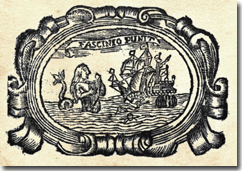
Para entender la propiedad, es necesario aueriguar si ay sirenas,
porque algunos dizen, que estas son como el aue Fenix, y que como es
fabulosa la vna, lo es la otra. De anbas aze mencion el Texto
Sagrado. (B)
Marginal note: (B) Et quasi Phoenix multiplicabo dies meos. Iob. 29.
Translat. Heb.
Hans Holbein, Historiarum Veteris Testamenti imagines ad vivum
expressae, Lyons: Fratres Frellonii 1543
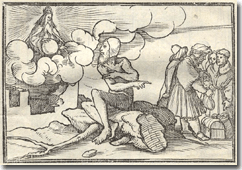
Iob alloquitur Dominus, ostendens ei suam iustitiam ex
inscrutabilibus suis operibus.
Biblia sacra polyglotta, ed. Brianus Waltonus, London: Thomas Roycroft 1657, II. 56.
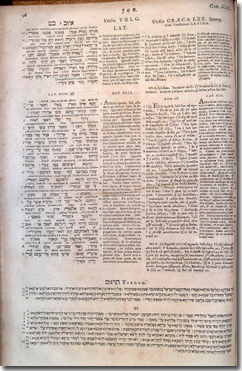
• איוב : כט
ואמר עם־קני אגוע וכחול ארבה ימים׃
Et dicebam, cum meo nido expirabo: & sicut arenam
multiplicabo dies.
• תרגום Targum (Paraphrasis Chald.):
ואמרת עם תוקפי בשרכפי אתנגיד וכחלא אסגי יומיא׃
Et dixi: Cum fortitudine mea in nido meo deficiam; & sicut arena
multiplicabo dies.
•
Versio Graeca LXX. Interpretorum:
Εἶπα δὲ,
Ἡ ἡλικία
μου γηράσει ὥσπερ στέλεχος φοίνικος,
πολὺν
χρόνον
βιώσω.
Dixi autem, Aetas mea senescet, sicut truncus palmae: multo vivam
tempore. •
Versio Vulgata:
Dicebamque: In nidulo meo moriar, & sicut palma multiplicabo dies.
Psalm 103:5
המשביע בטוב עדיך תתחדש כנשר נעוריכי׃
Rashi on Job 29:18
וכחול ארבה ימים - עוף ושמו חול ולא
נקנסה עליו מיתה שלא טעם
מעץ הדעת ולבסוף אלף שנה מתחד׳ וחוזר לנערותו׃
Bereshit Rabbah 19:15
האכילה את הבהמה ואת החיה ואת העופות הכל שמעו לה חוץ מעוף אחד ושמו חול הה״ד
(איוב
כט)
וכחול ארבה ימים דבי רבי ינאי אמרי אלף שנה הוא חי ובסוף אלף שנה אש יוצאה מקנו
ושורפתו ומשתייר בו כביצה וחוזר ומגדל אברים וחי ר׳ יודן בר״ש אומר אלף שנים חי
ולבסוף אלף שנים גופו כלה וכנפיו מתמרטין ומשתייר בו כביצה וחוזר ומגדל אברים׃
Talmud Bavli, Sanhedrin 108b
אורשינה אשכחיניה אבא דגני בספנא דתיבותא אמר ליה לא בעית מזוני אמר
ליה חזיתיך דהות טרידא אמינא לא אצערך אמר ליה יהא רעוא דלא תמות שנאמר
(איוב כט) ואמר עם קני אגוע וכחול ארבה ימים׃
Biblia sacra cum Glossa ordinaria... et annotationibus de Nicolaus a
Lyra, Venice 1603, III. 277.
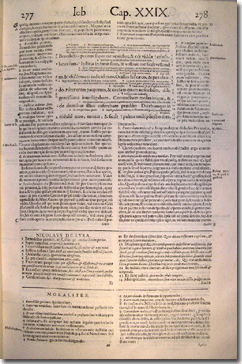
Codurcus, Annotata ad Iob, Frankfurt 1695, 885.
18. Dicebam itaque] Haec meritò
speravit Job, ὃ γὰρ ἐὰν σπείρη ἄνθρωπος
τοῦτο καὶ θερίσει, ut ait Apostolus ad Gal. 6. 7. Sed tempus
messis patienter exspectandum, & multa ferenda,
ἀγαθοποιοῦντες οὖν μὴ ἐκκακῶμεν.
Moriar in nido meo.] Hebr.
Cum nido meo exspirabo. Unde quorundam Hebraeorum in mentem
venit elegantissima interpretatio, quae à Jarrhio affertur. Dicit
avem esse cujus nomen est
חול quae nunquam moritur,
quod de arbore Scientiae non gustaverit; sed post mille annos
renovatur, atque iterum cernitur in primo juventae flore. Haec è
Rabbinis traduntur in Bereschit Rabba, & in codice Sanedrin, ut
refert Baal Haruch, omnes gustasse de arbore Scientiae, unâ
exceptâ ave cui nomen est
כחול .חול
Masora notat bis inveniri. Atque in nostris exemplaribus excusis
literae
כ attexitur Siman alterius loci על שפת הים. Loca
illa sunt 1. Sam. 13. 5.
כחול אשר על שפת הים & 2. Sam. 17. 11. Sed Mercerus
asserit se in Masora Bibliorum manuscr. Reginae legisse
ב׳ בתרו ליש׳, i.
bis in diversa significatione. Unde sequitur hîc juxta illam
Masoram non significare arenam, quia apud Samuelem id
significat. Dubium non est avem illam, esse nostrum fabulosum
phoenicem. Hinc manavit error Graeci interpretis, qui
חול
στέλεχος φοίνικος interpretatur.
Acceperat ab aliquo Judaeo
חול esse phoenicem
quod illi imposuit. Nam Judaeus intellexit avem, Graecus arborem
putavit. Latina Vulgata obsecuta est Graeco, & palmam vertit:
sed
חול nunquam palmam
significat.
חול apud Rabbinos opponitur
Sabbato, estque dies profestus, dies profanus. Vide
Eliam in Thisbi. Est quidem scita admodum & lepida illa Rabbinorum
interpretatio, sed inani fabula nixa. Tritum est in Scriptura per
arenam significari numerum innumerum & copiam maximam, ut Psal.
139. 18.
מחול ירבון de Divinis cogitationibus dictum, quarum magnitudo &
multitudo arenas superat.
Juan de Horozco y Covarrubias, Sacra symbola, Agrigento 1601,
Emblem 6: Ut vivam
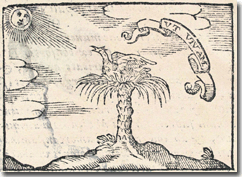
En tal fuego de amor santo
No puede ser consumida,
Antes se alarga la vida.
Flamma Dei viuax succenso in pectore veram
Non adimit vitam, quae renouata viget.
Fray Luis de León, Commentated translation of the Book of Job (between
1580 and 1585), MS 219 of the Library of the University of Salamanca (ed. by Javier San José Lera, 1992, II. pp. 632 and 637)
Y decíame: en mi nido espiraré, y multiplicaré como paloma. (f.
329v)
Y decíame, esto es, y prometíame a mí: espiraré en mi nido, esto es,
en mi casa y mi descanso, llegaré hasta el día postrero, y
multiplicaré mis días como paloma, o como arena, según otra letra;
esto es, viviré largos años: porque a la piedad y al bien hazer
promete en sus Letras Dios larga vida. (f. 333v)
Juan de Pineda, Commentaria in Job, Cologne 1733 (first ed.
1597-1601), II. 329 and 337.
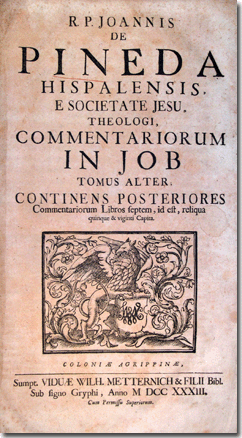
Et sicut palma multiplicabo dies. Statuebam (inquit) fore, ut
diutissime viverem sicut palma. Sed de palma nunc
significatione non parva est dissentio: nam eandem vocem originalem
Hhol, (חול) Vulgatus interpres vertit arenam, Deuter. 33. 19. & Psalm.
138. 18. Super arenam multiplicabuntur, & Hoseae. 1. 10.
Filii Israel, quasi arena maris. Quare hic quidem vertunt:
Sicut arena multiplicabo dies: nam cum arena quaelibet,
quantumvis maxima multiplicatio numeri comparari solet. Alii post R.
Salomonem & antiquiores Hebraeos, Phoenicem vertunt quod
sequuntur Tygurina & Cajetanus. Atque hunc etiam Jobi locum
Tertullianus de Resurrectione cap. 13. legit: Sicut Phoenix
multiplicabo dies, atque adeo Philippus Presbyter hoc loco
testatur, idem esse Palma & Phoenicis avis nomen,
fortassisque de ave loquutum Jobum, ut sicut illa nidum sibi
faciens, in ipso post multa tempora, à semetipsa dicitur concremari,
& rursus de ejusdem nidi cineribus resurgere; ita Job dicat se per
mortem in cinere carnis, velut in nido pro tempore futurum & inde
resurrecturum in gloria, de quo diximus supra cap. 19. v. 25.
ubi etiam lectionem illam Psalm. 91. Justus ut Phoenix florebit,
ex Tertulliano adduximus. Facitque cum hac expositione, tum quod
Phoenix sit symbolum vitae longissimae: nam vivere sexcentis
sexaginta annis, scribit Plinius, at vero quingentis,
Ambrosius, & Hieronymus, post Herodotum & Ovidium. Hac ubique
quinque suae complevit saecula vitae, &c. Quadraginta & quingentis,
Solinus, cum quo videtur convenire Mela. Alii mille annos vitae
tribuunt, ut Martialis:
Qualiter Assyrios revocant incendia nidos,
Una decem quotiens saecula vixit avis.
Tacitus scribit esse qui asserant, Mille quadringentos sexaginta
vivere. Scribit etiam Plinius auctore Manilio: Cum hujus
alitis vita fieri conversionem magni anni. Quamvis (inquit
Solinus) plurimi auctores magnum annum, non quingentis &
quadraginta, sed duodecim milibus nongentis quinquaginta quatuor
annis constare dicant. Recte ergo dici potest per elegantem
Hyperbolen, atque comparationem, Sicut palma, Phoenix
multiplicabo dies. Facitque pro eodem mentio illa nidi facta,
nam videtur non solum vitam longaevam mortemque foelicissimam sibi
pollicitus, sed honorificentissimum quoque funus. Nam suum Phoenix
rogum, nidumque construit ex thuriferis surculis lignisque
odoriferis, in quo concrematur. Atque adeo Herodotus scribit:
Phoenicem juvenem gestare patrem paternosve cineres myrrha obvolutos
in templum Solis, ibi denique humare. Ergo mors funusque
Phoenicis supremi honoris, funerisque honorificentissimi symbolum
erit.
Sed Palmam, tamen hoc loco praeter Latinum Interpretem,
agnoscunt leguntque Septuaginta: Sicut truncus palmae, multo
vivam tempore, ubi forte truncum, dixerunt, tum propter
firmitatem tum propter gradatos illos corticis pollices, quos cum
faciunt rami decidentes singulis annis, annuis gradibus crescere
videtur, adeoque in trunco palmae, multi anni numerantur.
Atque sicut rem illam de Phoenice ave juvare videbatur mentio illa
nidi, ita rem hanc de Palma confirmat profecto mentio Radicis
aperta secus aquas, sententia sequente.
Paraphrasis: ... Et sicut palma multiplicabo dies.
Firma quoque spe sustentabar fore, ut non minus diuturnam vitam
ducerem, quam Phoenix, cujus est vita longissima; aut quam palma, in
cujus trunco multi anni ex decidentibus annuatim ramis numerari
possunt.
|